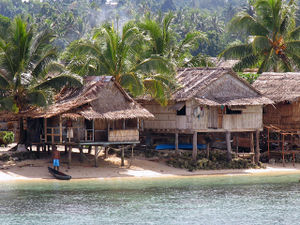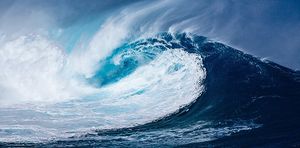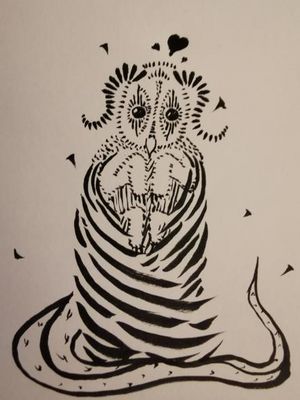Mythologies on Jute
Mythologies on Jute refer to the various, interconnected sets and systems of mythological stories and beliefs that exist on Jute. The four main ones are the traditional Coastal Jutean mythology, the River Jutean mythology, the Samwati mythology and the Klambari mythology, however, there are also many smaller ones of other ethnic and religious minorities, e.g. of the Jutean Balak community or the Prime Temple Cult in Sitti. While they have influenced each other to varying amounts due to many centuries of coexistence, they do not have a shared origin and have also been subject to overseas influence.
Coastal and River Jutean mythology originate from the beliefs and mythical stories of Proto-Jutic speakers who settled on Jute about 3,000 years ago, and Samwati and Klambari mythology developed from the mythology of neolithic cultures that arrived from the Püzimm peninsula on the continent on Baredina 4,000 to 5,000 years ago and formed the first inhabitants of the island. Other major origins and influences include Qurosist beliefs brought in by the Saruan Empire from the 17th to the 19th century, and Zarasaist beliefs by the Balak Empire in the 19th and 20th century.
Coastal Jutean mythology
Myths about settlement of the island and life on it
Traditional Coastal Jutean mythology originates largely in stories chronicling the past and present of their communities. Due to isolation of the original communities and historical upheavals there tend to be many versions of a singular myth, but in general, they are mostly concerned with the origin and development of the Coastal Jutean communities at the central and southern coast of the main island as well as the proper social behavior and the right relationship with the environment.
The most important settlement myths are the following:
- Tahi a saanede a iki a hohi ("Story of the first new beach"), about the arrival on Jute and scouting.
- Tahi a jutaide ("Story of the settlement"), about the initial settlement at the coast, the first houses, harvests etc.
- Tahi a Netumode a Saan ("Story of Netumo a Saan"), about a famous semi-mythical guard and proto-community leader.
- Tahi a nonaf a livunuhide ("Stories of the communities of the east"), about various other communities, located further inward, likely River Juteans.
- Tahi a vatasainide ("Story of the Stonepeople"), about "stonepeople", a community surrounded by mysterious stone ruins.
The most important myths about life in society and the dangers surrounding are:
- Tahi a nuluade a deletu ("Story of the monkey-like siblings"), about two siblings who behaved like monkeys and their ultimate fate.
- Tahi a nihamode nav netude ("Story of the elders near the border of civilization"), about the wisdom and advice of elders living at the edge of the unknown jungle.
- Tahi a fivoude u lumode a vanede ("Story of storms at sea and the power of nature"), about the dangers of boating in the ocean, a cautionary tale
- Tahi a tahimode a afuva u hajeohi ("Story of the fat, intelligent storyteller"), is a story teaching listeners not to just judge people by their appearance, a story of empowerment.
Myths about the environment
Myths about rainforests and oceans themselves or the creatures said to be living within both feature less prominently, although they are nonetheless important. There are plenty of just-so stories intended for children where the origin of a particular animal, plant or anything else in the world is purported to be explained, as in for example Nekko: ana a niki u ton li savanhude ("Coconut fiber: where it comes from and how it came to Earth"). Furthermore, there are several key mythological concepts, such as the the Veil, which is said to be located on the ocean and appears e.g. in Tahi a ni a saanude. ("Living story of the ocean"), which details the voyage of the ancestors of Juteans across the ocean and the sea. These Tahi a ni or "Living stories" sit at the intersection of historical and religious myth, drawing from both topics, and are characterized by continuous change over time. Tahi a ni a netude ("Living story of the frontier"), a narration of life before the voyage and settlement on Jute, is another example.
Myths about the supernatural and the spiritual
Supernatural beings are otherwise largely downplayed and uncommon in storytelling, with the various Olumohi-type creation stories that arose with development of Saandism, e.g. Olumohi a savanhu ("Creation of the universe"), being an exception. Like most myths they exist in dozens of different variants, but most feature abstract entities such as waves, geometrical shapes or mandalas, residing in the world of ideas, which gave birth to the natural world. Direct interact with these entities of creation is not possible, only indirect perception via the study of mathematics and philosophy.
Other spirits, immaterial and ethereal "intermediate" creations such as the Datu, reside between the two worlds and might make themselves apparent to humans sometimes, via form, temperature or other means, but are generally seen at best as a distraction that can interfere with life, and at worst a lethal danger and are hence best avoided. Consequently, they are generally rarely part of myths, to not encourage interest in contacting, let alone summoning dangerous spirits, with the exception of cautionary tales, although this can vary from community to community, myths tend to only include regular humans and sometimes wild or tamed animals. For similar reasons, mythological animals are usually absent, too, as are humans with supernatural powers, to not distract from the general goal of promoting the special state of contentment and inner peace known as saandi and not instill e.g. longings for special powers.
Ways to reach saandi feature in many stories. A few stand out due to being tied to cosmology as well, which is outside of the creation myths an uncommon topic in Coastal Jutean mythology. An example of such a myth is Tahi a Saa ("The waving story" or "Story of Waves"). A counterpart to the Olumohi creation stories and in some ways its inversion, it narrates how all kinds of waves, such as sea waves, are widely seen as the most primeval part of the material world and the most direct link to the abstract world of ideas and its truths, and being close to them and internalizing their characteristics is said to be conductive to all spiritual journeys, mental pursuits and social endeavors, as all motion in the world and history is said to be ultimately cyclical, or resembling waves.
River Jutean mythology
River Jutean mythology has many things in common with Coastal Jutean mythology, but due to the distinct environment of the rainforested inland surrounding the river Tahoon a haad and its tributaries and heavy influence from the nearby Samwati communities is usually seen as "transitional" between the two.
While the relationship of humans and their communities with their environment as well as individual spiritual enlightenment remains central, it is the natural environment rather than the human settlements that is at the center. Especially rivers and rainforests and Lake Samwati/Jehaadufi are a recurring theme and setting in many myths, with the lake being seen as the place where the traditional homeland ends, and the foreign lands, including the world of spirits, begin.
These supernatural beings are said to have their home at the bottom of the lake, although they can also be encountered in other places. While spirits can be ethereal and immaterial, resembling no known living being as in Coastal Jutean mythology, anthropomorphic spirits are common, too and generally the supernatural features prominently, with humans said to be capable of having supernatural abilities. The most important one is channeling the spirits of dead people, a central concept of River Jutean Saandism. A famous myth is about the girl who snatched the ability to channel from spirits and then brought it to her community, Lightning Shield.
Samwati mythology
In Samwati mythology the vast river network of the homeland of the Samwati and and rainforest surrounding it, including Lake Samwati play an important role. Their mythological role in the world, the legendary creatures and monsters of otherworldly nature with supernatural powers that can be encountered in them as well as attempts to defeat or tame them are the most common themes of myths. The protagonists are usually the six character archetypes from the Samwati religion. The myths vary a lot from community to community and are also normally re-invented by every generation.
Some of these myths began to be adapted into the other mythologies early on, at the latest at the time of the tetrarchy ruling Jute, and their popularity grew further when in the 18th century guides to the Samwati religion and its mythology began to be printed in large numbers in the languages spoken throughout the island group. Today, they frequently serve as inspiration for novels and other works of art, and due to the success of some of those abroad, these myth are widely seen as the most iconic myths from Jute, the most well-known one being what is usually termed the legend of an owl-lizard traditionally named the Ruler of the Ether, but in modern times commonly known by the Coastal Jutean name Datu.
Klambari mythology
Klambari mythology is closely related to Samwati mythology. As such, it also emphasizes the natural environment, which it also has in common with River Jutean mythology. The hilly terrain that the Klambari communities are located in, and there especially the volcanoes and the river Ambato that flows through the region like a lifeline are both the central themes and settings of myths. These can be about the origin or special characteristics of these geographic features and the spirits and other supernatural beings that dwell within them, and are often tied into narrations of the heroic deeds and difficult fights of legendary people, either acting solitary or in groups, protecting their communities from wild and terrible beasts as well as other calamities, often of the supernatural kind. Some myths, especially told to children, feature animals as protagonists, otherwise humans of all ages tend to be protagonists.


